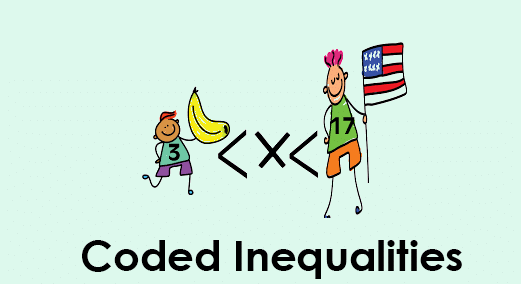Coded Inequalities, Introduction and Examples (with Solutions), Reasoning (Part - 1) | Reasoning Ability for Banking Exams - Bank Exams PDF Download
| Table of contents |

|
| Introduction |

|
| Understanding the Symbols |

|
| Format of Coded Inequalities |

|
| Examples |

|
Introduction
Coded inequalities are a type of logical reasoning problem commonly found in competitive exams, aptitude tests, and assessments designed to evaluate logical thinking and problem-solving skills.

These problems involve a series of statements where elements are related to each other through coded symbols rather than explicit numbers or words.
The challenge lies in deciphering these relationships and drawing logical conclusions based on the given coded statements.
Understanding the Symbols
Before delving into coded inequalities, it's essential to grasp the meaning of the symbols used:
- A > B: A is greater than B
- A < B: A is less than B
- A = B: A is equal to B
- A ≥ B: A is greater than or equal to B
- A ≤ B: A is less than or equal to B
These symbols establish relationships between elements and form the basis of deriving conclusions from coded statements.
Format of Coded Inequalities
Coded inequalities are typically presented in the form of statements where elements are connected by symbols indicating their relationships. Each statement can involve multiple elements, and the symbols may vary within the statement. Here’s an example format:
Example Statement: X > Y ≥ Z < W
In this statement:
- X is greater than Y
- Y is greater than or equal to Z
- Z is less than W
Steps to Solve Coded Inequalities:
Analyze the Statement: Carefully read and understand the relationships between the elements as indicated by the coded symbols.
Establish Logical Order: Determine the logical order of elements based on the given relationships. This helps in visualizing the hierarchy or sequence of elements.
Draw Inferences: Based on the established relationships, draw logical conclusions about the relationships between specific elements or their positions relative to each other.
Verify Conclusions: Validate each conclusion against the coded statement to ensure it aligns logically with the given relationships.
Examples
Example 1:
Coded Inequalities:
- means
- means
Statement:
What does the statement P#Q@R mean?
a)
b)
c)
d)
Solution:
- means
- means
Correct Answer: b)
Example 2:
Coded Inequalities:
- means
- means
Statement:
What does the statement X&Y$Z mean?
a)
b)
c)
d)
Solution:
- means
- means Y≤Z
Correct Answer: c)
Example 3:
Coded Inequalities:
- A\*B means
- means
Statement:
What does the statement M#N\*O mean?
a)
b)
c)
d)
Solution:
- means
- N\*O means
Correct Answer: c)
Example 4:
Coded Inequalities:
- means
- means
Statement:
What does the statement K@L&M mean?
a)
b)
c)
d)
Solution:
- means
- means
Correct Answer: b)
Example 5:
Coded Inequalities:
- means
- means
Statement:
What does the statement P$Q#R mean?
a)
b)
c)
d)
Solution:
- means
- means
Correct Answer: c)
Tips for Solving Coded Inequalities
- Practice: Familiarize yourself with different types of coded statements and practice deriving conclusions.
- Logical Deduction: Focus on logical deduction rather than assumptions or external knowledge.
- Step-by-Step Approach: Break down each statement into simpler relationships and proceed step-by-step to draw conclusions.
[Intext Question]
Coded inequalities require a methodical approach to decipher relationships between elements based on coded symbols. By understanding the symbols, analyzing the statements, and logically deducing conclusions, you can effectively tackle these problems in exams and assessments. Regular practice is key to mastering this skill and improving your accuracy in solving coded inequalities.
|
43 videos|79 docs|41 tests
|
FAQs on Coded Inequalities, Introduction and Examples (with Solutions), Reasoning (Part - 1) - Reasoning Ability for Banking Exams - Bank Exams
| 1. What are coded inequalities? |  |
| 2. How can I solve coded inequality questions? |  |
| 3. Can you provide an example of a coded inequality question? |  |
| 4. How do I represent the decoded information in coded inequality questions? |  |
| 5. Are there any tips or strategies for solving coded inequality questions? |  |
















